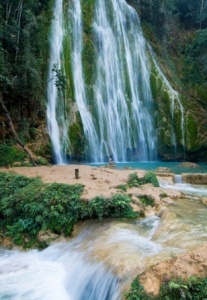Dominican Republic’s exuberant ecotourism provides countless escapes

Dominican Republic is the Caribbean’s most bio-diverse country, with 25 percent of its lush land and pristine coastline protected as national parks, reserves and sanctuaries. With the creation of the Dominican Republic’s Marine Mammal Sanctuary for Humpback Whales in 1962, Dominican Republic has been a forerunner in environment and marine-oriented protections ensuring magnificent nature abounds.
“We work hard to preserve Dominican Republic’s nine distinct ecological zones so that visitors can have incredible eco-adventures and witness nature’s wonders,” said Magaly Toribio , Marketing Advisor for the Dominican Republic Ministry of Tourism. “Our 19 national parks, many forest reserves, natural monuments and wildlife refuges are a national treasure protected for generations to come.”
January through March is an especially exciting time in Dominican Republic as up to 5,000 whales migrate to the Northeast Coast and Samana Bay ‘s warm waters. The males claim the outer bays while the females nurse their young by the inner cove’s shallow waters. It is a sight to see, and tours make it easily accessible.
While whale watching is must, so is visiting these top Dominican ecological escapes:
Los Haitises National Park: Step back in time and sense what the world was like millions of years ago in Samana’s Los Haitises National Park, one of the world’s most marvelous and mysterious treasures. The mangrove swamps, islets and caves are meant to be explored.
The 27 Waterfalls of Damajagua: The 27 Waterfalls of Damajagua, located 30 minutes from Puerto Plata in the Northern Corridor mountain range, is one of Dominican Republic’s best-kept secrets. Your adrenaline will undoubtedly kick-in as you hike to and from each waterfall – jumping from the tops, and swimming and sliding your way back to the base camp.
ADVERTISEMENT
Kiteboard: Located just east of Puerto Plata , Cabarete is the kiteboarding capital of the world. Its mixture of sundrenched beaches, perfect winds and seamless waves create ideal kiteboarding conditions. If you have never ridden a kiteboard, instructors give daily lessons and provide the necessary equipment.
Jarabacoa: Located in Dominican Republic’s La Vega Province, Jarabacoa is considered the country’s ecotourism birthplace and the ideal spot for a breathtaking horseback ride. Often called the “city of eternal spring” by Dominicans, the town’s steady climate provides ideal weather for outdoor adventures.
Saona Island: Take a catamaran from Bayahibe Beach in La Romana and you’ll see the National Park of the East, the sea’s natural pool and a mangrove swamp reserve before reaching Saona Island – the country’s largest off-shore island. Stretching 42 square miles (68k), it boasts more than 112 species of birds, turtles, sharks, bottle-nose dolphins and manatees.
El Limon Waterfall: Visit the Samana Peninsula’s interiors where the mountains reach up 2,100 feet (640m). Mule ride along steep paths surrounded by tropical vegetation, coffee and cocoa plants, and wildlife. Once you reach the top, you will be amazed by the sight. Join in as other onlookers put their cameras aside and plunge into the waterfall’s cool and calming rush.
Bahia de las Aguilas: On Dominican Republic’s Southwest Coast is Pedernales, a bio-diverse locale with abundant nature and breathtaking views. Must-sees include the flora-filled Jaragua National Park, Lake Enriquillo, the deepest point in the Caribbean and Bahia de las Aguilas, a striking beach made up of fine white sand and coral reefs.

